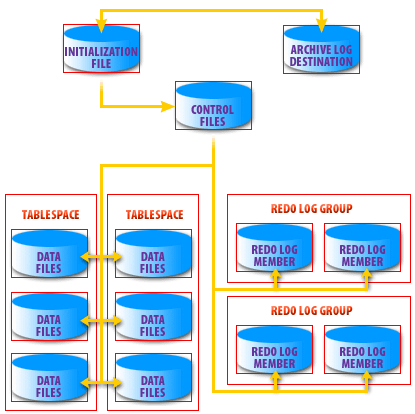Database File types

- Initialization file: Contains parameters that specify the database block size, the amount of memory to use for the Shared Global Area (SGA), and that control other aspects of how the database instance operates.
- Control files: Keeps track of all the files that make up a database.
- Archive log destination: This is the location to which Oracle copies redo log files when they are filled.
- Tablespace: Tablespaces are logical storage structures that contain table and index data. Oracle allows you to map a tablespace onto one or more physical files.
- Datafiles: These are the files that hold the data for tables and indexes. They are the reason all the other files exist.
- Redo log group: A group of one or more redo log files that Oracle treats as one. Oracle writes the same information to each file in a group.
- Redo log member: Stores a log of all changes made to the database (the redo log), that is used in the event that the database needs to be recovered.
Oracle 18C Cloud Infrastructure Components
Oracle 18c Cloud Infrastructure is a comprehensive cloud platform that provides a range of infrastructure services for deploying and managing applications in the cloud. The infrastructure consists of a number of components, including:
Overall, Oracle 18c Cloud Infrastructure provides a complete and integrated platform for deploying, managing, and scaling applications in the cloud, making it easier for organizations to take advantage of the benefits of cloud computing.
- Compute: This provides virtualized compute resources, including virtual machines (VMs), bare metal instances, and containers.
- Networking: This provides virtual networking services, including virtual private clouds (VPCs), subnets, routing tables, and security groups.
- Storage: This provides scalable and highly available storage services, including block storage, file storage, and object storage.
- Database: This provides managed database services, including Oracle Database, MySQL, and PostgreSQL, as well as cloud-native databases like Autonomous Database.
- Load Balancing: This provides load balancing services to distribute incoming traffic across multiple compute resources, improving performance and availability.
- Identity and Access Management (IAM): This provides a centralized platform for managing user identities, permissions, and access to cloud resources.
- Monitoring and Logging: This provides monitoring and logging services to track the health and performance of cloud resources, and to diagnose and troubleshoot issues.
- Management and Governance: This provides a range of tools and services for managing and governing cloud resources, including automation, cost management, and security.
Overall, Oracle 18c Cloud Infrastructure provides a complete and integrated platform for deploying, managing, and scaling applications in the cloud, making it easier for organizations to take advantage of the benefits of cloud computing.